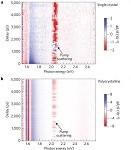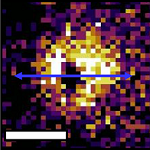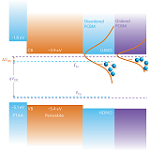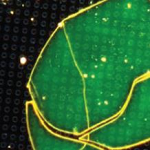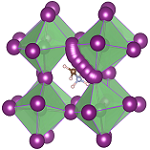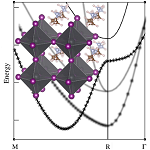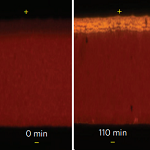Physics
The ground exciton state of formamidinium lead bromide perovskite nanocrystals is a singlet dark state
Philippe Tamarat et al., Nat. Mater. 18, 717-724 (2019) doi:10.1038/s41563-019-0364-x
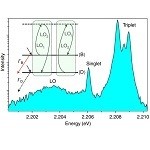
Unveiling the operation mechanism of layered perovskite solar cells
Yun Lin et al., Nat. Commun. 10, 1008 (2019) doi:10.1038/s41467-019-08958-9
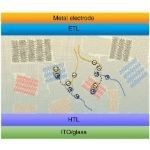 It is well-accepted that the two dimensional layered halide perovskite can improve the device stability of perovskite solar cells but the operation mechanism remains unclear. Here Lin et al. reveal the real morphology of the hot-cast layered perovskite solar cells and understand the working mechanism.
It is well-accepted that the two dimensional layered halide perovskite can improve the device stability of perovskite solar cells but the operation mechanism remains unclear. Here Lin et al. reveal the real morphology of the hot-cast layered perovskite solar cells and understand the working mechanism.
Phonon coherences reveal the polaronic character of excitons in two-dimensional lead halide perovskites
Félix Thouin et al., Nat. Mater. 18, 349-356 (2019) doi:10.1038/s41563-018-0262-7
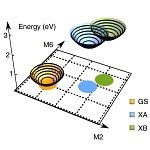
Atomic scale insights into structure instability and decomposition pathway of methylammonium lead iodide perovskite
Shulin Chen et al., Nat. Commun. 9, 4807 (2018) doi:10.1038/s41467-018-07177-y
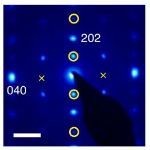 Hybrid perovskites are highly promising for photovoltaic applications, but they are prone to decomposition. Here, the authors probe the stability of CH3NH3PbI3 films in a transmission electron microscope, defining the threshold conditions to avoid damage under the electron beam, and describing a decomposition pathway.
Hybrid perovskites are highly promising for photovoltaic applications, but they are prone to decomposition. Here, the authors probe the stability of CH3NH3PbI3 films in a transmission electron microscope, defining the threshold conditions to avoid damage under the electron beam, and describing a decomposition pathway.
Large electrostrictive response in lead halide perovskites
Bo Chen et al., Nat. Mater. 17, 1020-1026 (2018) doi:10.1038/s41563-018-0170-x
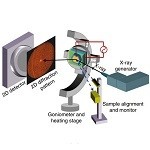
Molecularly thin two-dimensional hybrid perovskites with tunable optoelectronic properties due to reversible surface relaxation
Kai Leng et al., Nat. Mater. 17, 908-914 (2018) doi:10.1038/s41563-018-0164-8
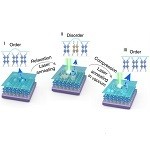
Understanding how excess lead iodide precursor improves halide perovskite solar cell performance
Byung-wook Park et al., Nat. Commun. 9, 3301 (2018) doi:10.1038/s41467-018-05583-w
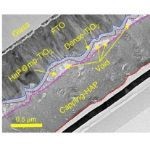 Excess lead iodide in the mixed halide perovskites solar cells leads to high device performance but its origin remains elusive. Here Park et al. unveil the underlying microscopic mechanism to be promoting the oriented growth of the perovskites crystals and reducing the defect concentration.
Excess lead iodide in the mixed halide perovskites solar cells leads to high device performance but its origin remains elusive. Here Park et al. unveil the underlying microscopic mechanism to be promoting the oriented growth of the perovskites crystals and reducing the defect concentration.
From the archive
Spin control in reduced–dimensional chiral perovskites
Guankui Long et al., Nat. Photon. 12, 528-533 (2018) doi:10.1038/s41566-018-0220-6
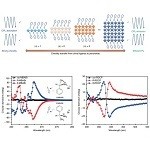
Cross-plane coherent acoustic phonons in two-dimensional organic-inorganic hybrid perovskites
Peijun Guo et al., Nat. Commun. 9, 2019 (2018) doi:10.1038/s41467-018-04429-9
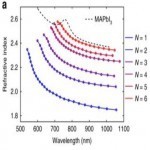 Two-dimensional, organic-inorganic hybrid perovskites have sustained research interest due to attractive optoelectronic and excitonic properties. Here, Guo et al. systematically investigate coherent acoustic phonon transport versus layer thickness in these materials with strong acoustic impedance mismatch.
Two-dimensional, organic-inorganic hybrid perovskites have sustained research interest due to attractive optoelectronic and excitonic properties. Here, Guo et al. systematically investigate coherent acoustic phonon transport versus layer thickness in these materials with strong acoustic impedance mismatch.
Inversion symmetry and bulk Rashba effect in methylammonium lead iodide perovskite single crystals
Kyle Frohna et al., Nat. Commun. 9, 1829 (2018) doi:10.1038/s41467-018-04212-w
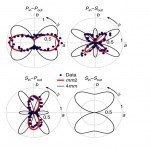 The high performance of hybrid perovskite solar cells has attracted significant attention but the nature of the underlying mechanisms remains unclear. Frohna et al. show methylammonium lead iodide perovskite is centrosymmetric, invalidating previous predictions of a large bulk Rashba effect.
The high performance of hybrid perovskite solar cells has attracted significant attention but the nature of the underlying mechanisms remains unclear. Frohna et al. show methylammonium lead iodide perovskite is centrosymmetric, invalidating previous predictions of a large bulk Rashba effect.
Design principles for electronic charge transport in solution-processed vertically stacked 2D perovskite quantum wells
Hsinhan Tsai et al., Nat. Commun. 9, 2130 (2018) doi:10.1038/s41467-018-04430-2
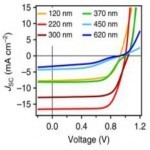 Solution-processed two dimensional perovskite quantum well based optoelectronic devices have attracted great research interest but their electrical transport is poorly understood. Tsai et al. reveal that the potential barriers of the quantum wells dominate the transport properties in solar cell devices.
Solution-processed two dimensional perovskite quantum well based optoelectronic devices have attracted great research interest but their electrical transport is poorly understood. Tsai et al. reveal that the potential barriers of the quantum wells dominate the transport properties in solar cell devices.
Hybrid perovskite films approaching the radiative limit with over 90% photoluminescence quantum efficiency
Ian L. Braly et al., Nat. Photon. 12, 355-361 (2018) doi:10.1038/s41566-018-0154-z
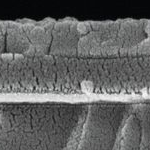
Large tunable photoeffect on ion conduction in halide perovskites and implications for photodecomposition
Gee Yeong Kim et al., Nat. Mater. 17, 445-449 (2018) doi:10.1038/s41563-018-0038-0
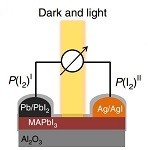
Spin-polarized exciton quantum beating in hybrid organic–inorganic perovskites
Patrick Odenthal et al., Nat. Phys. 13, 894-899 (2017) doi:10.1038/nphys4145
 Hybrid perovskites are known to have excellent optoelectronic properties, but the observation of exciton states with long spin lifetimes suggests that they may also have potential spintronics applications. Shareable link
Hybrid perovskites are known to have excellent optoelectronic properties, but the observation of exciton states with long spin lifetimes suggests that they may also have potential spintronics applications. Shareable link
Giant five-photon absorption from multidimensional core-shell halide perovskite colloidal nanocrystals
Weiqiang Chen et al., Nat. Commun. 8, 15198 (2017) doi:10.1038/ncomms15198
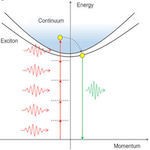 The small high-order multi-photon action cross-section of traditional biological imaging media presents a fundamental limitation for deep-tissue nonlinear optical imaging. Here the authors overcome this limitation by employing multidimensional core-shell perovskite nanocrystals.
The small high-order multi-photon action cross-section of traditional biological imaging media presents a fundamental limitation for deep-tissue nonlinear optical imaging. Here the authors overcome this limitation by employing multidimensional core-shell perovskite nanocrystals.
Spatially segregated free-carrier and exciton populations in individual lead halide perovskite grains
S. Nah et al., Nat. Photon. 11, 285-288 (2017) doi:10.1038/nphoton.2017.36
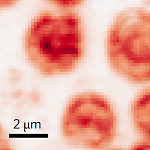
Top and bottom surfaces limit carrier lifetime in lead iodide perovskite film
Ye Yang et al., Nat. Energy, 2, 16207 (2017) doi:10.1038/nenergy.2016.207
Understanding surface carrier dynamics enables the design of optimal optoelectronic devices. Yang et al. find that surface recombination limits the total carrier lifetime in polycrystalline lead iodide perovskite films, meaning recombination at surfaces is more important than within and between grains. Shareable link
Enhancing photoluminescence yields in lead halide perovskites by photon recycling and light out-coupling
Johannes M. Richter et al., Nat. Commun. 7, 13941 (2016) doi:10.1038/ncomms13941
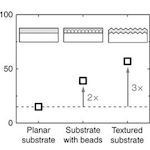 The use of textured active layers can increase the external photoluminescence yield of lead halide perovskite from 15% to 57% via photon recycling and light out-coupling, showing the ability to improve power conversion efficiencies for both LEDs and solar cells.
The use of textured active layers can increase the external photoluminescence yield of lead halide perovskite from 15% to 57% via photon recycling and light out-coupling, showing the ability to improve power conversion efficiencies for both LEDs and solar cells.
Accelerated degradation of methylammonium lead iodide perovskite induced by exposure to iodine vapor
Shenghao Wang et al., Nat. Energy, 2, 16195 (2016) doi:10.1038/nenergy.2016.195
Extensive efforts are under way to tackle the degradation issue—one of the biggest challenges for the practical application of perovskite-based solar cells. Here the authors show that CH3NH3PbI3 and several other iodine-containing perovskites are inherently unstable due to decomposition caused by self-generated I2. Shareable link
Direct–indirect character of the bandgap in methylammonium lead iodide perovskite
Eline M. Hutter et al., Nat. Mater. 16, 115-120 (2017) doi:10.1038/nmat4765
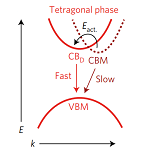
Photo-induced halide redistribution in organic–inorganic perovskite films
Dane W. deQuilettes et al., Nat. Commun. 7, 11683 (2016) doi:10.1038/ncomms11683
Visual evidence for photo-induced ionic migration in perovskite films without contacts is lacking. Here, the authors use a unique combination of confocal photoluminescence microscopy and chemical imaging to correlate the local changes in photophysics with composition in CH3NH3PbI3 films under illumination.
Correlation of energy disorder and open-circuit voltage in hybrid perovskite solar cells
Yuchuan Shao et al., Nat. Energy 1, 15001 (2016), doi:10.1038/nenergy.2015.1
Ongoing efforts are devoted to raising the efficiency of solar cells in converting energy from solar radiation. Now, improved structural order in the charge transport layers of perovskite solar cells is shown to increase the efficiency from 17.1% to 19.4%. Shareable Link
Laser cooling of organic-inorganic lead halide perovskites
Son-Tung Ha et al., Nat. Photon. 10, 115-121 (2016), doi:10.1038/nphoton.2015.243
Perovskite crystals are shown to be highly efficient materials for optical refrigeration, supporting cooling of up to 58 K when exposed to laser light. Shareable Link
Ionic transport in hybrid lead iodide perovskite solar cells
Christopher Eames et al., Nat. Commun. 6, 7497 (2015), doi:10.1038/ncomms8497
Understanding the mechanism of ionic transport in organic-inorganic halide perovskites is crucial for the design of future solar cells. Here, Eames et al. undertake a combined experimental and computational study to elucidate the ion conducting species and help rationalise the unusual behaviour observed in these perovskite-based devices.
Direct measurement of the exciton binding energy and effective masses for charge carriers in organic–inorganic tri-halide perovskites
Atsuhiko Miyata et al., Nat. Phys. 11, 582-587 (2015), doi:10.1038/nphys3357
Direct measurement of the exciton binding energy shows that the impressive performance of perovskite solar cells arises from the spontaneous generation of free electrons and holes after light absorption. Shareable Link
Revealing the role of organic cations in hybrid halide perovskite CH3NH3PbI3
Carlo Motta et al., Nat. Commun. 6, 7026 (2015) doi:10.1038/ncomms8026
Hybrid halide perovskite solar cells are studied as easy to fabricate compounds for efficient solar cell devices. Here, the authors use density functional theory calculations to show that the orientation of the organic molecules in these materials is crucial for their electronic and solar conversion properties.
Giant switchable photovoltaic effect in organometal trihalide perovskite devices
Zhengguo Xiao et al., Nat. Mater. 14, 193-198 (2015), doi:10.1038/nmat4150
The direction of the current photogenerated in organic-inorganic perovskite films can be switched by poling the material with low electric fields that induce a reversible ion drift. Hybrid perovskites may thus find application as memristor devices. Shareable Link


